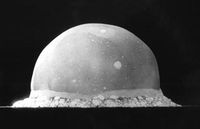CZ:Featured article/Current: Difference between revisions
imported>Chunbum Park |
imported>Chunbum Park No edit summary |
||
| Line 1: | Line 1: | ||
== '''[[ | == '''[[Los Alamos National Laboratory]]''' == | ||
''by [[User: | ''by [[User:Milton Beychok|Milton Beychok]], [[User:Ro Thorpe|Ro Thorpe]] and [[User:Daniel Mietchen|Daniel Mietchen]] | ||
---- | ---- | ||
'''Los Alamos National Laboratory''' (LANL), located in [[Los Alamos]], [[New Mexico]], is one of several [[U.S. Department of Energy]] (DOE) national laboratories. It is noteworthy as the site where the first [[atomic weapon]] was developed under a heavy cloak of secrecy during [[World War II]], and has been known variously as '''''Site Y''''', '''''Los Alamos Laboratory''''', and '''''Los Alamos Scientific Laboratory'''''. Today, it is recognized as one of the world's leading science and technology institutes. | |||
{{Image|Trinity test.jpg|right|200px|Trinity test of an [[Nuclear weapon|atomic bomb]] on July 15, 1945 at 0.016 seconds after detonation. The fireball was about 200 metres wide.}} | |||
Since 2006, LANL has been managed and operated by [[Los Alamos National Security, LLC]] (LANS).<ref name=LANS/> | |||
LANL's self-stated mission is to ensure the safety, security, and reliability of the nation's nuclear deterrent.<ref name=LANL-Mission/> Its research work serves to advance [[Biology|bioscience]], [[chemistry]], [[computer science]], [[Earth science|earth]] and [[environmental science]]s, [[materials science]], and [[physics]] disciplines.<ref name=LANL-About/><ref name=LANL-Overview/> | |||
===History=== | |||
The [[Manhattan Project]] was the secret [[United States]] project conducted primarily during [[World War II]] with the participation of the [[United Kingdom]] and [[Canada]] that culminated in developing the world's first [[nuclear weapon]], commonly referred to at that time as an ''atomic bomb''. | |||
The project was initiated in 1939 by [[U.S. President]] [[Franklin Delano Roosevelt]] after he received a letter from physicist [[Albert Einstein]] (drafted by fellow physicist [[Leó Szilárd]]) urging the study of [[nuclear fission]] for military purposes, under fears that [[Nazi Germany]] would be first to develop nuclear weapons. Roosevelt started a small investigation into the matter, which eventually became the massive [[Manhattan Project]] that employed more than 130,000 people at universities across the United States, the United Kingdom and Canada as well as at the three major design, development and production facilities: Los Alamos; Hanford, Washington; and Oak Ridge, Tennessee. | |||
''[[ | ''[[Los Alamos National Laboratory|.... (read more)]]'' | ||
{| class="wikitable collapsible collapsed" style="width: 90%; float: center; margin: 0.5em 1em 0.8em 0px;" | {| class="wikitable collapsible collapsed" style="width: 90%; float: center; margin: 0.5em 1em 0.8em 0px;" | ||
|- | |- | ||
! style="text-align: center;" | [[ | ! style="text-align: center;" | [[Los Alamos National Laboratory#References|notes]] | ||
|- | |- | ||
| | | | ||
{{reflist|2}} | {{reflist|2}} | ||
|} | |} | ||
Revision as of 20:03, 1 March 2012
Los Alamos National Laboratory
by Milton Beychok, Ro Thorpe and Daniel Mietchen
Los Alamos National Laboratory (LANL), located in Los Alamos, New Mexico, is one of several U.S. Department of Energy (DOE) national laboratories. It is noteworthy as the site where the first atomic weapon was developed under a heavy cloak of secrecy during World War II, and has been known variously as Site Y, Los Alamos Laboratory, and Los Alamos Scientific Laboratory. Today, it is recognized as one of the world's leading science and technology institutes.

Trinity test of an atomic bomb on July 15, 1945 at 0.016 seconds after detonation. The fireball was about 200 metres wide.
Since 2006, LANL has been managed and operated by Los Alamos National Security, LLC (LANS).[1] LANL's self-stated mission is to ensure the safety, security, and reliability of the nation's nuclear deterrent.[2] Its research work serves to advance bioscience, chemistry, computer science, earth and environmental sciences, materials science, and physics disciplines.[3][4]
History
The Manhattan Project was the secret United States project conducted primarily during World War II with the participation of the United Kingdom and Canada that culminated in developing the world's first nuclear weapon, commonly referred to at that time as an atomic bomb.
The project was initiated in 1939 by U.S. President Franklin Delano Roosevelt after he received a letter from physicist Albert Einstein (drafted by fellow physicist Leó Szilárd) urging the study of nuclear fission for military purposes, under fears that Nazi Germany would be first to develop nuclear weapons. Roosevelt started a small investigation into the matter, which eventually became the massive Manhattan Project that employed more than 130,000 people at universities across the United States, the United Kingdom and Canada as well as at the three major design, development and production facilities: Los Alamos; Hanford, Washington; and Oak Ridge, Tennessee.
| notes |
|---|
|